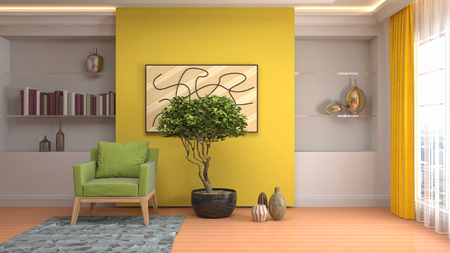Introduction to Natural Colours in Indian Wall Paints
India has a rich legacy of using natural colours in wall paints, deeply rooted in Ayurvedic principles and traditional craftsmanship. In recent years, there has been a strong resurgence of interest among Indian homeowners and architects towards eco-friendly and sustainable choices for interior design. This shift is not just about aesthetic appeal; it is closely linked to concerns about personal health, environmental impact, and the desire to reconnect with India’s cultural heritage. As synthetic paints often contain harmful chemicals, families across India are now rediscovering the benefits of natural pigments derived from minerals, plants, and earth-based materials. These natural colours are celebrated for their non-toxic properties, ability to regulate indoor air quality, and their role in creating serene, spiritually uplifting spaces that reflect both modern aspirations and time-honoured traditions. The use of natural wall paints aligns perfectly with the growing emphasis on sustainability, wellness, and holistic living that defines contemporary Indian homes today.
2. Ayurvedic Principles Behind Colour Usage
Ayurveda, the ancient Indian science of life and wellness, has long emphasised the importance of colours in shaping human experiences within living spaces. According to Ayurvedic philosophy, every colour is linked to specific energies (doshas) – Vata, Pitta, and Kapha – and each hue can influence mental, physical, and emotional well-being. The strategic use of natural colours in wall paints thus goes far beyond aesthetics; it is a thoughtful act rooted in harmony and holistic health.
The Role of Doshas in Colour Selection
In Ayurveda, balancing the three doshas is essential for overall health. Colours are chosen based on their ability to soothe or energise these energies within the home environment:
| Dosha | Recommended Colours | Effects on Wellbeing |
|---|---|---|
| Vata (Air & Ether) | Earthy tones like ochre, terracotta, soft browns, warm yellows | Grounding, warmth, calming anxiety |
| Pitta (Fire & Water) | Cool shades such as mint green, sky blue, gentle whites | Soothe aggression, promote calmness |
| Kapha (Water & Earth) | Lively hues like saffron yellow, light orange, fresh greens | Energising, uplifting mood |
Cultural Significance and Environmental Harmony
The selection of natural pigments like turmeric yellow, indigo blue, or red oxide is not only guided by their doshic impact but also by deep-rooted cultural beliefs. In Indian tradition, certain colours are associated with auspiciousness and purity. For example, red signifies vitality and positivity during festivals and ceremonies; white symbolises peace and spiritual growth.
Sustainable Living through Traditional Colours
Ayurveda also promotes environmental sustainability by advocating for plant-based or mineral-derived pigments that do not harm nature or human health. This approach aligns with the Indian ethos of Vasudhaiva Kutumbakam—the world is one family—encouraging harmony between individuals and their surroundings.

3. Traditional Indian Natural Pigments and Materials
India’s rich heritage in natural wall painting is rooted in the use of indigenous pigments and materials, celebrated for their vibrant hues and holistic benefits. For centuries, artisans have sourced colours from nature, ensuring that the walls not only radiate beauty but also promote health and sustainability—values deeply embedded in Indian culture and Ayurveda.
Turmeric: The Sacred Golden Yellow
Turmeric, known locally as haldi, is revered both as a culinary spice and a sacred substance. Its bright yellow pigment is commonly used in traditional wall paints, imparting not just colour but also antibacterial properties. In rural homes and temples, turmeric-based washes are applied to walls to create an auspicious atmosphere while naturally deterring insects and germs.
Indigo: Timeless Blue from Nature
Indigo, or neel, derived from the leaves of the Indigofera tinctoria plant, has been a staple for producing deep blue shades in wall paintings. Historically popular in Rajasthan and Gujarat, indigo offers a cooling effect to interiors—a perfect adaptation to India’s warm climate. The process involves fermentation and careful extraction, reflecting age-old wisdom passed down through generations.
Red Oxide: Earthy Elegance
Red oxide pigment, sourced from naturally occurring iron-rich soils, is widely used across India to achieve earthy reds and browns. Especially common in Kerala and Tamil Nadu, red oxide is prized for its durability and resistance to weathering. It is often mixed with lime for wall finishing in traditional homes and heritage buildings.
Cow Dung: Ancestral Eco-Friendly Binder
Cow dung holds a unique place in Indian tradition—not just as fuel or manure but also as a vital ingredient in wall coatings. When combined with clay or lime, it acts as a natural binder, providing insulation and pest resistance. Many rural communities still use cow dung plasters to maintain cool interiors and purify living spaces, following practices prescribed in ancient texts.
Other Herbal, Mineral, and Plant-Based Ingredients
Apart from these iconic pigments, Indian artisans incorporate a variety of other herbal extracts (like neem leaves for greenish tints), minerals (such as chalk or shell lime for whites), and plant saps (like gum arabic) into their paint recipes. These ingredients are chosen not only for their aesthetic appeal but also for their eco-friendly properties—reflecting an engineering mindset that optimises local resources for sustainable living.
This synergy between nature’s palette and traditional know-how continues to inspire modern wall paint innovations across India, keeping alive the spirit of ecological harmony and cultural pride.
4. Preparation Methods and Application Techniques
Step-by-Step Preparation Process
The preparation of natural wall paints in India is a time-honoured tradition, reflecting both Ayurvedic wisdom and regional craftsmanship. Below is a step-by-step guide that outlines the conventional processes, indigenous tools, and practical techniques involved:
| Step | Description | Indigenous Tools Used |
|---|---|---|
| 1. Selection of Raw Materials | Identify local sources for clay, cow dung, lime, natural resins, and herbal extracts such as neem or tulsi. Mineral pigments like red ochre (geru) and turmeric are commonly used. | Kudali (spade), Bamboo baskets |
| 2. Cleaning & Sieving | Remove impurities from raw materials by sieving and washing. Ensure fine texture for smooth application. | Sieve made of jute or metal mesh |
| 3. Grinding & Mixing | Grind minerals and herbs to powder form; blend with water, cow urine, or natural binders. Achieve a homogeneous paste. | Sil-batta (grinding stone), Wooden pestle |
| 4. Fermentation (Optional) | Allow the mixture to rest for 24-48 hours to enhance binding properties and colour depth. | Clay pots, Earthen vessels |
| 5. Straining & Final Dilution | Strain the mixture through cloth for a lump-free solution; adjust consistency using water or herbal decoction. | Cotton cloth, Hand stirrers |
| 6. Application on Walls | Apply using brushes made from coconut fibre or palm leaves; sometimes hands are used for textural finishes. | Coconut fibre brush, Palm leaf applicator, Human hand |
Regional Community Practices & Craftsmanship
Diverse regions in India have evolved their own unique styles and community practices for natural paint preparation and application:
- Rajasthan: Use of multani mitti (Fuller’s earth) mixed with red ochre for vibrant murals in Havelis; often applied by women in rural communities during festivals like Diwali.
- Madhya Pradesh: Gond and Bhil tribes utilize charcoal and plant extracts for intricate wall motifs using fingers or locally-made bamboo sticks.
- Bengal: Limewash blended with rice starch and indigo for smooth finishes in traditional bari ghar.
- Karnataka: Use of laterite soil combined with natural gums for rustic wall coatings in Malnad homes; usually applied by skilled village artisans.
Hands-on Techniques: Tips from Traditional Artisans
- Always mix paint in small batches to maintain freshness and consistency.
- Layering multiple thin coats enhances durability and brings out nuanced shades.
- Smoothing the final coat with banana leaves imparts a gentle sheen unique to South Indian practices.
- Addition of cow urine in certain regions is believed to offer antibacterial properties as per Ayurvedic guidelines.
Cultural Significance of Community Participation
The making and application of natural colours is not just an art but also a communal activity, especially during auspicious occasions or housewarming ceremonies (Griha Pravesh Puja). Elders impart knowledge to younger generations, ensuring that the rich legacy of indigenous wall painting techniques continues to thrive across Bharat’s diverse landscape.
5. Cultural & Regional Influences
India’s rich tapestry of wall painting traditions reflects the country’s extraordinary diversity in climate, culture, and aesthetic sensibility. Each region has developed its own approach to natural colours in wall paints, deeply rooted in local customs and environmental factors. For instance, Kerala is known for its use of laterite earth tones and herbal pigments such as indigo and turmeric, blending seamlessly with the lush tropical surroundings and the Ayurvedic tradition prevalent in the state. Moving towards the west, Rajasthan showcases bold ochres, reds, and blues derived from minerals like red oxide and lapis lazuli; these hues not only complement the arid desert landscape but also reflect the opulence of Rajputana culture. In contrast, Bengal features softer palettes using rice-based binders and plant extracts, echoing both the region’s humid climate and its literary artistic heritage. Local festivals, religious beliefs, and architectural styles further influence paint choices—for example, earthy reds are favoured during Durga Puja celebrations in Bengal, while intricate frescoes adorned with natural dyes decorate Rajasthani havelis. Thus, regional identity shapes both the aesthetic and functional aspects of natural wall paints across India, creating a living legacy that continues to inspire contemporary design.
6. Benefits, Challenges, and Sustainable Future
Environmental & Health Benefits of Natural Colours
Adopting natural colours in wall paints—rooted deeply in Ayurvedic wisdom and Indian traditions—offers profound environmental and health benefits. Unlike chemical-based paints, natural pigments derived from minerals, plants, and herbs such as turmeric, indigo, or red ochre are non-toxic and low in volatile organic compounds (VOCs). This means improved indoor air quality and reduced risk of respiratory ailments, a crucial factor for Indian homes where families spend significant time indoors. Additionally, the use of locally sourced ingredients reduces carbon footprint and fosters rural livelihoods, strengthening Atmanirbhar Bharat’s vision.
Practical Challenges on the Ground
Despite these advantages, several practical challenges persist. The availability and consistency of raw materials can be influenced by seasonal changes or regional constraints. Furthermore, natural wall paints may have a shorter shelf life, different application techniques, or limited colour palettes compared to synthetic alternatives. For many urban Indian consumers used to glossy finishes and quick-drying solutions, there may be an adaptation period to accept subtle hues and textures that natural colours offer. Cost can also be a deterrent, as artisanal or small-batch production may initially be more expensive than mass-produced chemical paints.
Innovations by Indian Brands & Startups
Recognising these obstacles, innovative Indian brands and startups are bridging the gap between tradition and modern needs. Companies like Kharashilpa, Nirvana Being, and others are developing advanced formulations using nano-emulsions or hybrid binders that enhance durability while retaining the purity of natural ingredients. Some startups collaborate with local artisans and farmers to ensure a steady supply chain of indigenous pigments. Others focus on educating customers through workshops or demo homes showcasing the beauty and longevity of traditional wall finishes such as lime plaster mixed with herbal extracts.
Towards a Greener, Culturally Rooted Future
The growing awareness about sustainability among Indian consumers is driving demand for eco-friendly wall paints that honour cultural heritage. Government initiatives like ‘Make in India’ and Green Building norms further encourage this transition. As technology advances and economies of scale improve, it is expected that natural wall paints will become more accessible to mainstream audiences across metros and tier-2 cities alike. By combining ancient Ayurvedic principles with modern engineering optimisation, India is uniquely positioned to lead the world towards walls that breathe health, culture, and sustainability into every home.


